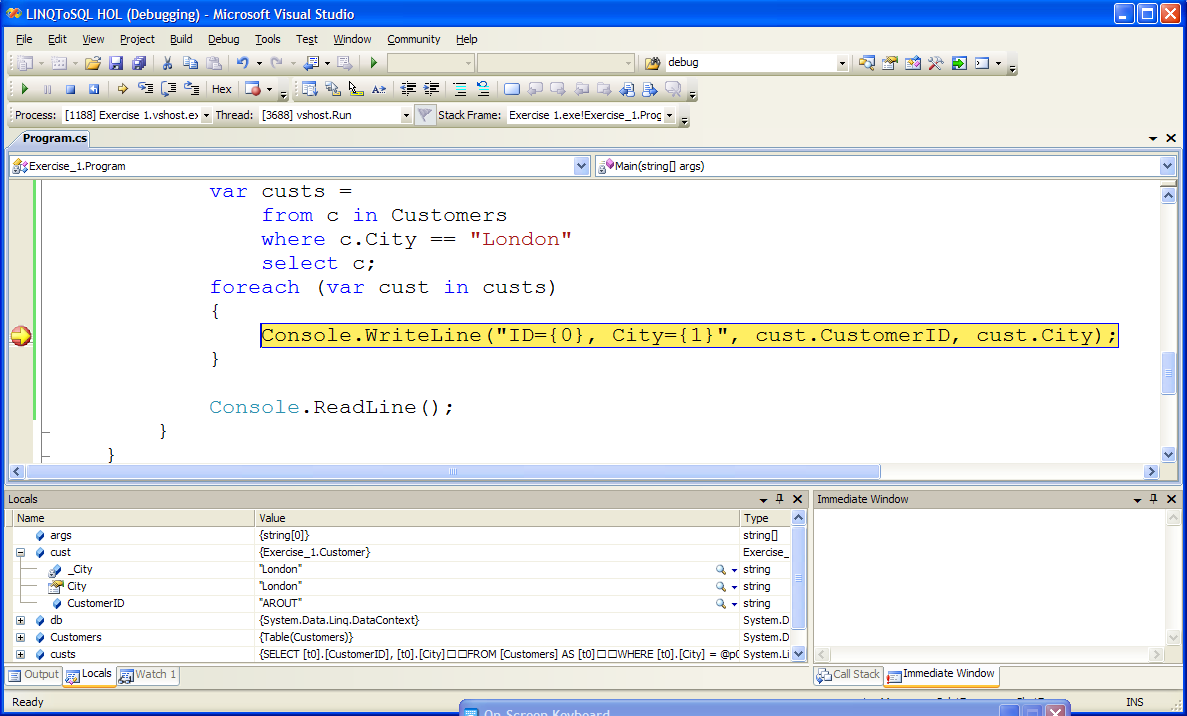
- •Contents
- •Lab 1: linq to sql: Database Language Integrated Queries
- •Lab Objective
- •Task 4 – Querying Database Data
- •Task 5 – Exploring the ide
- •Exercise 2 – Creating an Object Model
- •Task 1 – Creating the order entity
- •Task 2 – Mapping Relationships
- •Task 3 – Strongly Typing the DataContext Object
- •Exercise 3 Using Code Generation to Create the Object Model
- •Task 1 - Adding a linq to sql Classes file
- •Task 2 – Create your object model
- •Task 3 – Querying your object model
- •Task 4 – Mapping a stored procedure
- •Task 5 – Retrieving new results
- •Exercise 4 – Modifying Database Data
- •Task 1 – Modifying your object model
- •Task 2 – Creating a new Entity
- •Task 3 – Updating an Entity
- •Task 4 – Deleting an Entity
- •Task 5 – Submitting changes
- •Task 6 – Using Transactions
- •Lab Summary
Task 5 – Exploring the ide
In the C# editor select the Console.WriteLine line inside the foreach loop
In Microsoft Visual Studio, click the Debug | Toggle breakpoint menu command (or click F9)
Press F5 to debug the application
When the debugger stops the execution look at the locals window (or press Ctrl+D,L if the window doesn’t appear)
Inspect the variable cust to see its properties

You can also move the mouse over the variables and see how the IDE is fully aware of the type of the objects we have created.
Exercise 2 – Creating an Object Model
In this exercise, you will learn how to create a simple object model. Our first object model will be really simple and composed of two objects mapping to two database tables. Then we will see how to map relationships between objects to foreign key relationships between tables.
Task 1 – Creating the order entity
After the Customer class definition, create the Order entity class definition with the following code:
[Table(Name = "Orders")]
public class Order
{
private int _OrderID;
private string _CustomerID;
[Column(Storage = "_OrderID", DbType = "Int NOT NULL IDENTITY",
IsPrimaryKey = true, IsDbGenerated = true)]
public int OrderID
{
get { return this._OrderID; }
// No need to specify a setter because IsDbGenerated is true
}
[Column(Storage = "_CustomerID", DbType = "NChar(5)")]
public string CustomerID
{
get { return this._CustomerID; }
set { this._CustomerID = value; }
}
}
Task 2 – Mapping Relationships
Add a relationship between Orders and Customers with the following code, indicating that Orders.Customer relates as a foreign key to Customers.CustomerID:
[Table(Name = "Orders")]
public class Order
{
private int _OrderID;
private string _CustomerID;
[Column(Storage = "_OrderID", DbType = "Int NOT NULL IDENTITY",
IsPrimaryKey = true, IsDbGenerated = true)]
public int OrderID
{
get { return this._OrderID; }
// No need to specify a setter because AutoGen is true
}
[Column(Storage = "_CustomerID", DbType = "NChar(5)")]
public string CustomerID
{
get { return this._CustomerID; }
set { this._CustomerID = value; }
}
private EntityRef<Customer> _Customer;
public Order() { this._Customer = new EntityRef<Customer>(); }
[Association(Storage = "_Customer", ThisKey = "CustomerID")]
public Customer Customer
{
get { return this._Customer.Entity; }
set { this._Customer.Entity = value; }
}
}
LINQ to SQL allows to you express one-to-one and one-to-many relationships using the EntityRef and EntitySet types. The Association attribute is used for mapping a relationship. By creating the association above, you will be able to use the Order.Customer property to relate directly to the appropriate Customer object. By setting this declaratively, you avoid working with foreign key values to associate the corresponding objects manually. The EntityRef type is used in class Order because there is only one customer corresponding to a given Order.
Annotate the Customer class to indicate its relationship to the Order class. This is not strictly necessary, as defining it in either direction is sufficient to create the link; however, it allows you to easily navigate objects in either direction. Add the following code to the Customer class to navigate the association from the other direction:
public class Customer
{
private EntitySet<Order> _Orders;
public Customer() { this._Orders = new EntitySet<Order>(); }
[Association(Storage = "_Orders", OtherKey = "CustomerID")]
public EntitySet<Order> Orders
{
get { return this._Orders; }
set { this._Orders.Assign(value); }
}
…
}
Notice that you do not set the value of the _Orders object, but rather call its Assign method to create the proper assignment. The EntitySet type is used because from Customers to Orders, rows are related one-to-many: one Customers row to many Orders rows.
You can now access Order objects directly from the Customer objects, or vice versa. Modify the Main method with the following code to demonstrate an implicit join:
static void Main(string[] args)
{
// Use a standard connection string
DataContext db = new DataContext(@"Data Source=.\sqlexpress;Initial Catalog=Northwind");
// Get a typed table to run queries
Table<Customer> Customers = db.GetTable<Customer>();
// Attach the log showing generated SQL to console
// This is only for debugging / understanding the working of LINQ to SQL
db.Log = Console.Out;
// Query for customers who have placed orders
var custs =
from c in Customers
where c.Orders.Any()
select c;
foreach (var cust in custs)
{
Console.WriteLine("ID={0}, Qty={1}",
cust.CustomerID, cust.Orders.Count);
}
}
Press F5 to debug the solution
